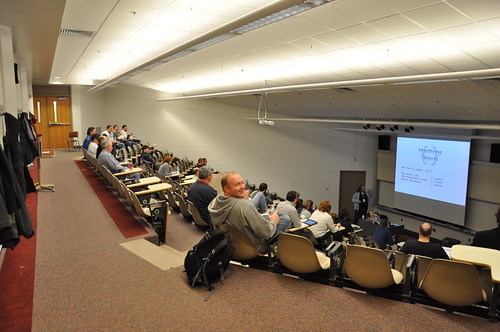Last week saw the first 24h hackathon event entirely dedicated to Kivy happening, in Paris. It was initiated by a hightly motivated student of the Cifacom school in paris, David Scheck, and attended by 4 groups of students, each with 3 to 5 members. I was pleased to share the hard task to help students discover the technology with my colleague Julien Miotte, from Majerti during the event.
The student weren’t very familiar with Python, and totally new to kivy, so it was a really challenging situation for both the student and the framework, would they be able to achieve anything in the hard limit of 24 hours?
First, after the students brainstormed on their project ideas, we got them through the major concepts and important classes of Kivy, using the Getting started page, it’s hard to get the point of properties accross in 10 minutes to student that didn’t have experienced the need of them, but I tried to at least make them aware it would be useful. The kv language presentation at this point, even if rudimentary, was probably useful, as we will see later.
Then students went on to try to build their project, except for a few quickly solved issues with windows installation, the starting was smooth. Julien and I gave some more explanations about how to start building a basic App (the doc is there, but who reads the doc? ;)) and people started designing their interface, and build the core of their application.

One of the most required feature was certainly the use of multiple screens in an application, to build menu, so the use of ScreenManager was explained to at least two groups. Most of the end results consisted of interfaces done mainly in Kv, and some internal logic to display data, most group had a quite ambitious target, using geolocalisation, databases, complex interactions, and I wasn’t very optimistic on the odds of seeing them completed. Although I was right in that, I was still happy of the good designs they came up with, applications were incomplete (to a notable exception, will come back to that soon), but some interfaces were beautiful, reactive and engaging, so it was nice to see the magic happen in such a short time.

One group had a very different objective of the others, and although they had a difficult start, it turns out they were probably the best at teamwork, and had chosen a target they could actually achieve, a game! These motivated coders/artists came up with a classic 2D sidescroller, when the main character has to avoid elements on her way. Simple, to the point, and a quite a good realisation in such a short time, the fact that they created original artworks and integrated them in their game, and that the general theme had a nice touch of humour in the current political events in France certainly hearned them points, on top of having a completed project. They even could test it on Android during the competition time, and it was running perfectly. Their hard work earned them the right to run in a bigger international competition in the near future the angel hack in paris, next month, congratulation! I can only hope they’ll chose kivy as their secret weapon in this competion too.

I would love to have better pictures, but i didn’t think much of taking them during the event, I should have better ones soon.

